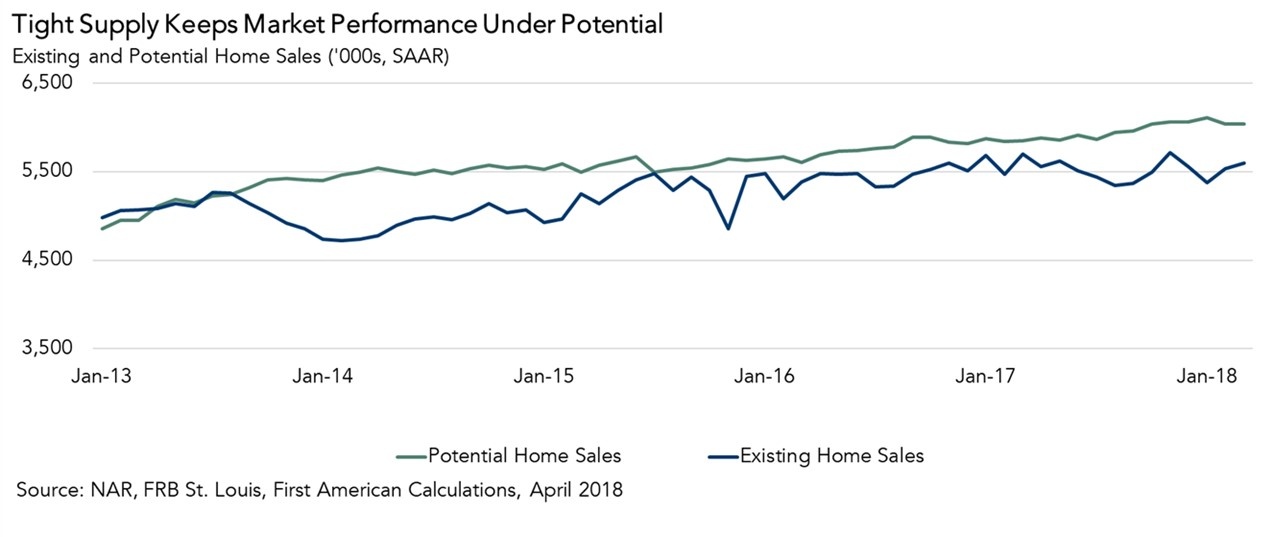In April, the housing market continued to underperform its potential. Existing-home sales were 6.5 percent below the market’s potential for existing-home sales, according to our Potential Home Sales Model. Lack of supply remains the primary culprit. The inventory of homes for sale in most markets remains historically low, yet demand continues to rise as millennials further age into homeownership.
“Understanding the resiliency of the housing market to a rising mortgage rate environment puts the likely rise in mortgage rates into perspective – they are unlikely to materially impact the housing market.”
One reason housing supply remains limited is because the majority of existing homeowners have 30-year, fixed-rate mortgages with historically low rates. Now that rates are rising, they are hesitant to sell their homes because there is less incentive to sell. If they sell, they would lose the low mortgage rate they currently have and replace it with a higher rate and a more expensive monthly loan payment. As mortgage rates rise further, more existing homeowners will become rate-locked into their current homes.
Given April’s 30-year, fixed mortgage rate of 4.47 percent, the market potential for existing-home sales at a seasonally adjusted annualized rate (SAAR) is 5.99 million. The early estimate of the annualized rate of existing-home sales in April was 5.60 million, so the market is underperforming its potential by an estimated 392,000 (SAAR) sales.
Surprise – Rate Increases of 25 or 50 Basis Points Have Little Impact on Market Potential
But, what may happen if mortgage rates increase another 25 or 50 basis points? According to our Potential Home Sales Model, if the 30-year, fixed-rate mortgage increases another 25 basis points, market potential for existing-home sales would fall by 11,500 sales. If the mortgage rate increased by 50 basis points, the market potential for existing-home sales would fall by 23,000 sales. While both increased rate scenarios reduce the market potential for existing-home sales, the reduction is small compared with the overall market potential for existing-home sales – almost 6 million sales.
Understanding the resiliency of the housing market in a rising mortgage rate environment puts the likely rise in mortgage rates into perspective – they are unlikely to materially impact the housing market. While interest rates may rise, the driving force behind the increase are healthy economic conditions that are favorable to consumers. The healthy economy encourages more homeownership demand and spurs household income growth, which increases consumer house-buying power. Mortgage rates are on the rise because of a stronger economy and our housing market is well positioned to adapt.

April 2018 Potential Home Sales
For the month of April, First American updated its proprietary Potential Home Sales model to show that:
- Potential existing-home sales increased to a 5.99 million seasonally adjusted annualized rate (SAAR), a 0.7 percent month-over-month decrease.
- This represents a 60.6 percent increase from the market potential low point reached in February 2011.
- The market potential for existing-home sales increased by 1.9 percent compared with a year ago, a gain of 114,000 (SAAR) sales.
- Currently, potential existing-home sales is 1.29 million (SAAR), or 17.7 percent below the pre-recession peak of market potential, which occurred in July 2005.
Market Performance Gap
- The market for existing-home sales is underperforming its potential by 6.5 percent or an estimated 392,000 (SAAR) sales.
- The market performance gap decreased by an estimated 39,000 (SAAR) sales between March 2018 and April 2018.
What Insight Does the Potential Home Sales Model Reveal?
When considering the right time to buy or sell a home, an important factor in the decision should be the market’s overall health, which is largely a function of supply and demand. Knowing how close the market is to a healthy level of activity can help consumers determine if it is a good time to buy or sell, and what might happen to the market in the future. That is difficult to assess when looking at the number of homes sold at a particular point in time without understanding the health of the market at that time. Historical context is critically important. Our Potential Home Sales Model measures what we believe a healthy market level of home sales should be based on the economic, demographic and housing market environments.
About the Potential Home Sales Model
Potential home sales measures existing-homes sales, which include single-family homes, townhomes, condominiums and co-ops on a seasonally adjusted annualized rate based on the historical relationship between existing-home sales and U.S. population demographic data, income and labor market conditions in the U.S. economy, price trends in the U.S. housing market, and conditions in the financial market. When the actual level of existing-home sales are significantly above potential home sales, the pace of turnover is not supported by market fundamentals and there is an increased likelihood of a market correction. Conversely, seasonally adjusted, annualized rates of actual existing-home sales below the level of potential existing-home sales indicate market turnover is underperforming the rate fundamentally supported by the current conditions. Actual seasonally adjusted annualized existing-home sales may exceed or fall short of the potential rate of sales for a variety of reasons, including non-traditional market conditions, policy constraints and market participant behavior. Recent potential home sale estimates are subject to revision in order to reflect the most up-to-date information available on the economy, housing market and financial conditions. The Potential Home Sales model is published prior to the National Association of Realtors’ Existing-Home Sales report each month.



